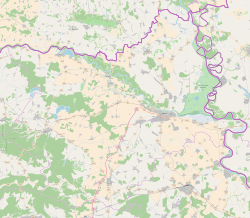Darda, Croatia
Darda | |
|---|---|
| Municipality of Darda Općina Darda | |
 | |
| Coordinates: 45°37′34″N 18°41′33″E / 45.626082°N 18.692513°E | |
| Country | |
| Region | Baranya (Podunavlje) |
| County | |
| Government | |
| • Mayor | Anto Vukoje |
| Area | |
| • Total | 92.24 km2 (35.61 sq mi) |
| • Village | 73.18 km2 (28.25 sq mi) |
| Population | |
| • Total | 6,908 |
| • Village | 5,323 |
| Time zone | UTC+1 (CET) |
Darda is a village and a municipality just north of Osijek, Croatia. It is located across the Drava river in Baranja. The population of the village is 5,323, with a total of 6,908 people in the municipality (2011 census).[2]
Name
In Hungarian the town is known as Dárda, in German as Lanzenau, and in Serbian Cyrillic as Дарда.[3] In Hungarian, a dárda (spear, lance) is made by ramming a dagger (tőr) into a long handle or pole. It was a military weapon used by the cavaliers and the infantry in the old times.[4]
History
It was first mentioned in 1280 as "Turda", later in 1282 as "Tharda", "Thorda", in 1290, 1299 as "Thorda", in 1332-1335 as "Turida", "Torda", later as (Kis-) és (Nagy-) Dárda, Dárda. During the Hungarian administration (13th-16th century), the area was part of the Baranya county. In the 16th-17th century, area was part of the Ottoman Empire and administratively belonged to the Sanjak of Mohaç. Ottoman traveler Evliya Çelebi in 1663 described Darda as an important market place with a strong fortress with towers. According to Çelebi, fortified part of the settlement had 50 houses and one mosque, while part of the settlement outside of the walls had one han and ten shops.
Since the end of the 17th century, area was part of the Habsburg Monarchy and administratively belonged to the Baranya county, which was part of the Habsburg Kingdom of Hungary. Darda was administratively included into the municipality of Baranyavár (Branjin Vrh) and in 1850 offices of local administration of this municipality were moved to Darda. In the end of the 18th century, Darda was a multi-ethnic settlement, mainly populated by Croats and Germans. In 1910, population included Germans, Croats and Hungarians.
Since 1918, Darda part of the Kingdom of Serbs, Croats and Slovenes (later renamed to Yugoslavia). From 1918 to 1922, it was part of the Novi Sad county, from 1922 to 1929 part of the Bačka Oblast, and from 1929 to 1941 part of the Danube Banovina. In 1941 it was occupied and re-annexed by Hungary and was administratively re-included into Baranya county. It was returned to Yugoslav control in 1944 and was administratively part of Vojvodina until 1945, when it was transferred to the People's Republic of Croatia.
During the Croatian War of Independence (1991–1995), Darda was incorporated, along with some other towns, into the unrecognized breakaway Republic of Serbian Krajina. It was returned to Croatian control after the war, following the short period of UN administration (1996–1998).
Darda is underdeveloped municipality which is statistically classified as the First Category Area of Special State Concern by the Government of Croatia.[5]
Geography
The municipality of Darda includes following settlements:
- Darda (population 5,394)
- Mece
- Švajcarnica
- Uglješ
Demographics
Largest ethnic groups in the municipality are (census 2001):[6]
- Croats (51.87%)
- Serbs (28.43%)
- Hungarians (8.23%)
- Romani (0.19%)
- Romanians (5.2%)
See also
References
- ^ "Općine na područjima posebne državne skrbi Republike Hrvatske" (PDF). Croatian Chamber of Economy. Retrieved 15 April 2020.
- ^ "Population by Age and Sex, by Settlements, 2011 Census: Darda". Census of Population, Households and Dwellings 2011. Zagreb: Croatian Bureau of Statistics. December 2012.
- ^ "Registar Geografskih Imena Nacionalnih Manjina Republike Hrvatske" (PDF). Archived from the original (PDF) on 29 October 2013. Retrieved 8 March 2013.
- ^ Czuczor Gergely, Fogarasi János: A magyar nyelv szótára - 1862.
- ^ Lovrinčević, Željko; Davor, Mikulić; Budak, Jelena (June 2004). "AREAS OF SPECIAL STATE CONCERN IN CROATIA- REGIONAL DEVELOPMENT DIFFERENCES AND THE DEMOGRAPHIC AND EDUCATIONAL CHARACTERISTICS". Ekonomski pregled, Vol.55 No.5-6. Archived from the original on 18 August 2018. Retrieved 25 August 2018.
- ^ http://www.dzs.hr/Hrv/censuses/Census2001/Popis/H01_02_02/H01_02_02_zup14.html
External links
- Official website (in Croatian)




